An empty glass with a piece of cotton wool stuck into its bottom was lowered in an upside down position into a trough of water. In the experiment, the cotton wool did not get wet even when glass was fully submerged in water. The experiment demonstrates that

Air has mass
Air occupies space
Air cannot be compressed
Both B and C.
The correct Answer is:B
Air has mass
Topper's Solved these Questions
- NSO QUESTION PAPER 2019-20 SET ABOOK - SCIENCE OLYMPIAD FOUNDATION CHAPTER - NSO QUESTION PAPER 2019-20 SET AEXERCISE - ACHIEVERS SECTION
1 Videos
- NSO QUESTION PAPER 2019- 20 SET - BBOOK - SCIENCE OLYMPIAD FOUNDATION CHAPTER - NSO QUESTION PAPER 2019- 20 SET - BEXERCISE - ACHIEVERS SECTION
1 Videos
- NSO QUESTION PAPER 2020-21 SET-ABOOK - SCIENCE OLYMPIAD FOUNDATION CHAPTER - NSO QUESTION PAPER 2020-21 SET-AEXERCISE - ACHIEVERS SECTION
1 Videos
Similar Questions
A shallow glass dish is 4.00cm wide at the bottom as shown in figure. When an observer's eye is positioned as shown, the observer sees the edge of the bottom of the empty dish. When this dish is 4.00cm wide at the bottom as shown in figure. When an observer's eye is positioned as shown, the observer sees the edge of the empty dish. When this dish is filled with water, the observer sees the centre of the bottom of the dish. Find the height of dish μw=4/3.
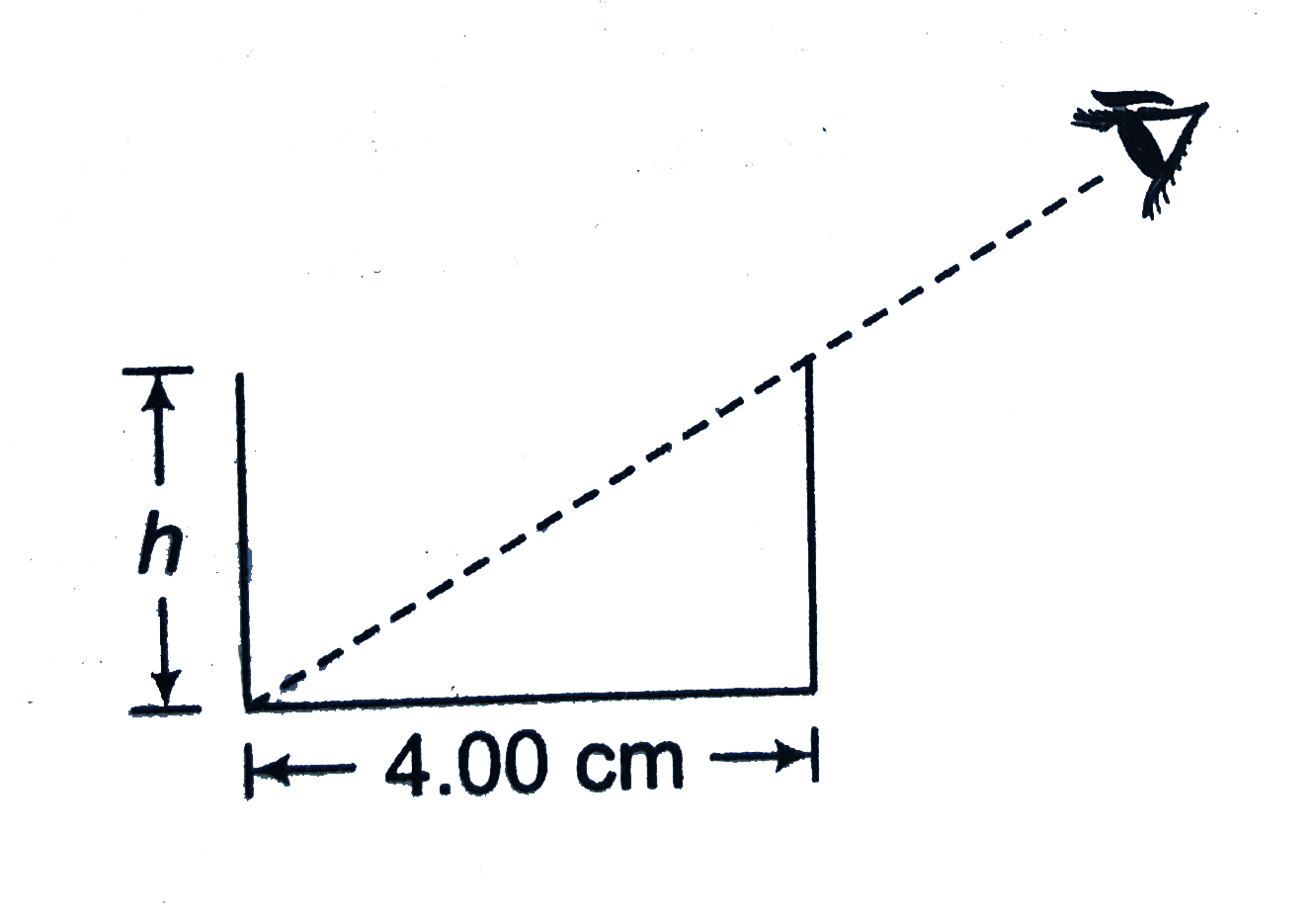
View SolutionA glass is filled with water up to its brim and a thick hand card placed on top of it. Now keeping the card tightly closed and pressed with palm, the glass full of water is inverted and placed upside down. The palm is gently removed from the card. It is observed that the piece of card does not fall off the glass though the glass is full of water and its whole weight is exerting pressure on the card. Why does it happen?
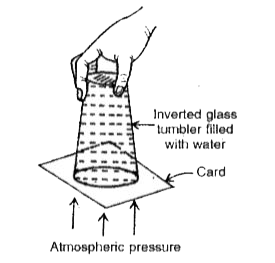
View Solution
Knowledge Check
For months the old tanker, African Queen , lay turned over on her side, stuck fast in the sands off the coast of Maryland. She had run aground so badly that her owners had decided to leave her to her fate. It was considered Impossible to refloat her and the ship began to rust and sink deeper and deeper into the sands. Men frequently came out in small boats and removed any parts that could be sold-until two men decided to attempt the impossible : to float the African Queen once more. Both men were engineers and had no experience of ships so that few people thought they could succeed.
The men began by studying the exact state of the African Queen and came to the conclusion that she would float again if air was pumped into the tanks which were now full of sea water. A diver was sent down to examine the underside of the ship. In the cold, dark water he found an enormous hole in her side which had been torn when the ship ran aground. It was plain that nothing could be done until the hole was repaired. As no single sheet of steel would cover it, the men were obliged to order a great number of sheets which had to be joined together. For several weeks divers worked continually to close the hole. At times, the sea was so rough that it was difficult to go down, and on more than one occasion, they had to contend with sharks.
At last the hole was covered and the men began to pump the sea-water out of the ship's tanks. It seemed as if they were bound to succeed, for when the tanks were full of air, the African Queen began to stir in the water. The men could not understand why she still would not float until they discovered that her rudder was embedded in mud. Huge cranes were brought to haul the sunken rudder out and the ship was again afloat. By this time, the men were almost exhausted. They had worked ceaselessly for three months to save the African Queen and had succeeded when everyone thought they would fail. Now they stood on the bridge of the ship, tired but proud, as tugs brought the African Queen into the harbour.
How did the two men propose to float the ship again?ABy sending divers to examine the darnage.BBy closing the large hole in her side.CBy joining a large number of steel sheets together.DBy pumping air into the tanks.Two pieces of cotton wool soaked separetely in aqueous solution of NH3 and HCl are placed at opposite ends of a close glass tube as shown in diagram
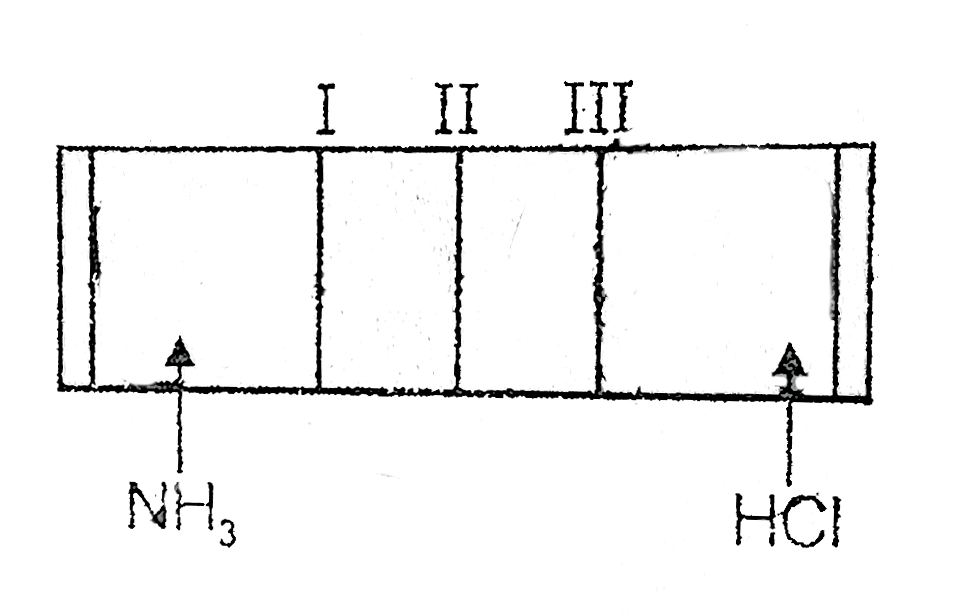
Select nearest position where white solid is formedAIBIICIIIDWhite solid does not formedAn empty glass jar is submerged in tank of water with open mouth of the jar downwards, so that air inside the jar is trapped and cannot get out. As the jar is pushed down slowly, the magnitude of net buoyant force on the system of volume of gas trapped in the jar and the jar.
 AincreasesBdecreasesCremain sameDInformation is insufficient to draw inference.
AincreasesBdecreasesCremain sameDInformation is insufficient to draw inference.
(i) A cylindrical container has area of cross section equal to 4A and it contains a non viscous liquid of density 2ρ. A wooden cylinder of cross sectional area A and length L has density ρ. It is held vertically with its lower surface touching the liquid. It is released from this position. Assume that the depth of the container is sufficient and the cylinder does not touch the bottom.
(a) Find amplitude of oscillation of the wooden cylinder.
(b) Find time period of its oscillation.
Two cubical blocks of side length a and 2a are stuck symmetrically as shown in the figure. The combined block is floating in water with the bigger block just submerged completely. The block is pushed down a little and released. Find the time period of its oscillation. Neglect viscostiy.
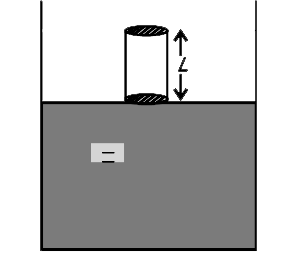
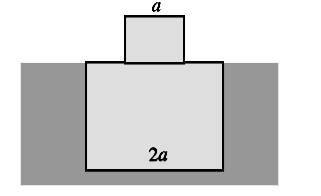
View SolutionAn empty glass jar is submerged in tank of water with open mouth of the jar downwards, so that air inside the jar is trapped and cannot get out. As the jar is pushed down slowly, the magnitude of net buoyant force on the system of volume of gas trapped in the jar and the jar.

View SolutionA flat bottomed thin-walled glass tube has a diameter of 4 cm and it weights 30 g. the centre of gravity of the empty tube is 10 cm above the bottom, find the amount of water which must be poured into the tube so that when it is floating vertically in a tank of water, the centre of gravity of the tube and its contents is at the midpoint ot the immersed length of the tube.
View SolutionAjay and Rakesh live in Rajgarh town of Churu districk of Rajasthan. As usual, the summer in this area of Rajasthan in extremely hot. Ajay's sister is getting engaged in the month of May, Ajay's family and relatives were waiting for the guests to arrive for the engagement ceremony. They had brought a slab of ice and put it in a tub of water for cooling the warm bottles of soft drinks. Just when they had finished drinking all the cold soft drink bottles, the gruests (including would-be bridegroom) arrive. Ajay and Rakesh were in a fix because they had only warm bottles of soft drinks left with them. Ajay suggested that they should put the warm soft drink bottles in the ice cold water which they already had in the tub but Rakesh did not agree with him Rakesh quickly brought a big slab of ice from the nearby shop crushed it well. He then put the warm soft drink bottles in an empty tub and surrounded them well with crushed ice. These warm soft drink bottles got colled in a short time and were served to the guests. All the guests enjoyed cold soft drinks on a very hot day and felt refreshed.
(a) What is the temperature of water formed from freshly melted ice ?
(b) What is the temperature of melting ice ?
(c) A person holds some ice-old water in his left hand palm and a piece of ice in his right hand palm. Which of the two will appear to be more cold and why ?
(d) Explain why, the warm drink bottles could be cooled more quickly by placing them in a tub of crushed ice than in a tub of ice cold water.
(e) Can you suggest another way in which the warm soft drinks can be cooled even more quickly by using ice (than by keeping the bottles in crushed ice) ?
(f) What type of change of state takes place when ice is used for cooling purposes ? What is the special name of this change of state ?
(g) What values are displayed by Rakesh in the episode ?
View SolutionIn Melde's experiment , when a string is stretched by a piece of glass it vibrates with 7l∞ps . When the glass piece is completely immersed in water the string vibrates in 9l∞ps. What is the specific gravity of glass ?
View Solution
